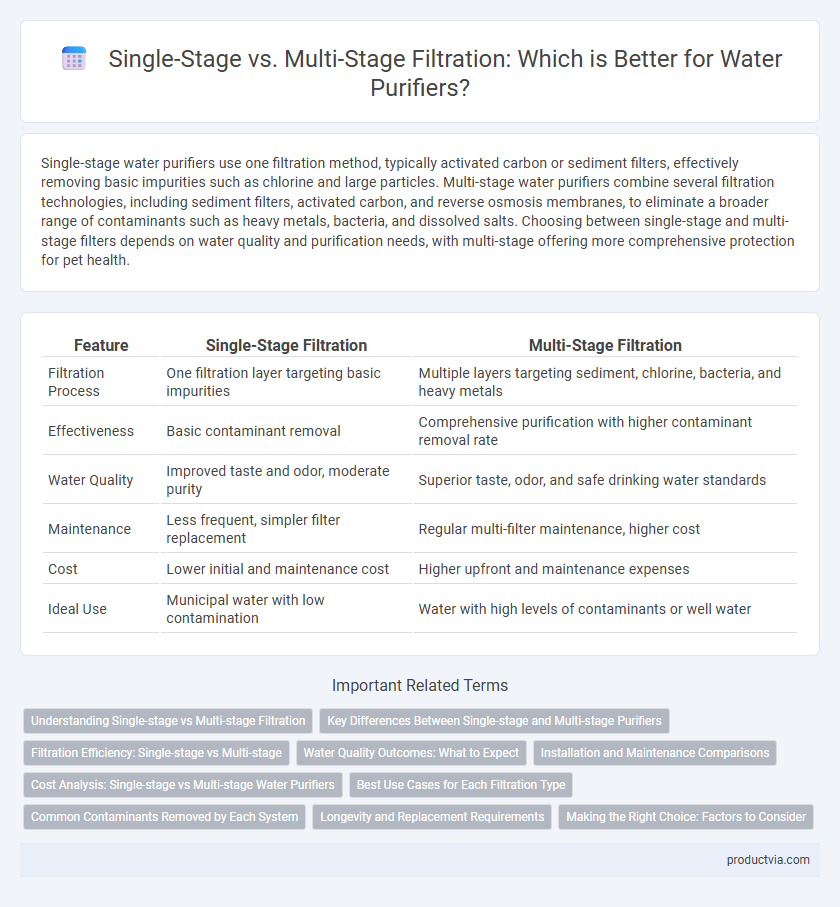Single-stage water purifiers use one filtration method, typically activated carbon or sediment filters, effectively removing basic impurities such as chlorine and large particles. Multi-stage water purifiers combine several filtration technologies, including sediment filters, activated carbon, and reverse osmosis membranes, to eliminate a broader range of contaminants such as heavy metals, bacteria, and dissolved salts. Choosing between single-stage and multi-stage filters depends on water quality and purification needs, with multi-stage offering more comprehensive protection for pet health.
Table of Comparison
| Feature | Single-Stage Filtration | Multi-Stage Filtration |
|---|---|---|
| Filtration Process | One filtration layer targeting basic impurities | Multiple layers targeting sediment, chlorine, bacteria, and heavy metals |
| Effectiveness | Basic contaminant removal | Comprehensive purification with higher contaminant removal rate |
| Water Quality | Improved taste and odor, moderate purity | Superior taste, odor, and safe drinking water standards |
| Maintenance | Less frequent, simpler filter replacement | Regular multi-filter maintenance, higher cost |
| Cost | Lower initial and maintenance cost | Higher upfront and maintenance expenses |
| Ideal Use | Municipal water with low contamination | Water with high levels of contaminants or well water |
Understanding Single-stage vs Multi-stage Filtration
Single-stage water purifiers use one filtration medium to remove contaminants, typically targeting sediment or chlorine, making them suitable for basic purification needs. Multi-stage filtration systems combine multiple filters such as sediment filters, activated carbon, reverse osmosis membranes, and UV purifiers to effectively eliminate a wider range of impurities including heavy metals, bacteria, and viruses. Choosing between single-stage and multi-stage filtration depends on water quality, desired purity levels, and budget considerations.
Key Differences Between Single-stage and Multi-stage Purifiers
Single-stage water purifiers use one filtration method, typically activated carbon or a basic sediment filter, to remove impurities such as chlorine and large particles. Multi-stage water purifiers combine several filtration technologies like sediment filters, activated carbon, UV sterilizers, and reverse osmosis membranes, effectively removing a broader range of contaminants including heavy metals, bacteria, viruses, and dissolved salts. The key differences lie in purification depth, efficiency, and suitability for various water sources, with multi-stage systems offering more comprehensive purification for complex or highly contaminated water.
Filtration Efficiency: Single-stage vs Multi-stage
Multi-stage water purifiers provide superior filtration efficiency by utilizing multiple layers such as sediment filters, activated carbon, and reverse osmosis membranes, effectively removing a broader range of contaminants including heavy metals, bacteria, and chlorine. Single-stage water purifiers typically rely on one filtration mechanism, like activated carbon, which is less effective at eliminating complex impurities and microorganisms. Consequently, multi-stage systems ensure higher water purity and safety by combining physical, chemical, and biological filtration processes.
Water Quality Outcomes: What to Expect
Single-stage water purifiers typically remove larger contaminants like sediments and chlorine, improving taste and odor but may leave behind smaller particles and bacteria. Multi-stage filtration systems combine multiple media such as activated carbon, reverse osmosis membranes, and UV filters to eliminate a broader range of impurities, including heavy metals, microorganisms, and dissolved solids. This comprehensive approach in multi-stage purifiers results in significantly higher water quality and safer drinking water compared to single-stage units.
Installation and Maintenance Comparisons
Single-stage water purifiers require simpler installation and minimal maintenance, making them ideal for areas with low sediment or contaminants. Multi-stage filtration systems involve complex installation processes due to multiple components and require regular upkeep, including filter replacements for each stage to ensure optimal performance. While multi-stage purifiers deliver enhanced water quality, their maintenance demands are higher compared to single-stage units.
Cost Analysis: Single-stage vs Multi-stage Water Purifiers
Single-stage water purifiers generally have a lower initial cost and reduced maintenance expenses due to fewer components, making them economically favorable for basic filtration needs. Multi-stage water purifiers, while more expensive upfront, offer comprehensive purification by combining sediment filters, activated carbon, and RO or UV technology, which can reduce long-term health costs by providing safer drinking water. Analyzing the total cost of ownership, multi-stage systems may deliver better value through improved water quality and fewer repairs over time despite the higher initial investment.
Best Use Cases for Each Filtration Type
Single-stage water purifiers provide effective removal of common contaminants such as sediment and chlorine, making them ideal for areas with relatively clean tap water or for users seeking affordable maintenance. Multi-stage filtration systems combine sediment filters, activated carbon, reverse osmosis, and UV purification, offering comprehensive removal of heavy metals, bacteria, viruses, and chemical pollutants, which is best suited for regions with heavily contaminated or uncertain water quality. Choosing between single-stage and multi-stage purifiers depends on water source conditions, desired purity level, and budget constraints.
Common Contaminants Removed by Each System
Single-stage water purifiers typically remove large particles, chlorine, and some sediments, making them suitable for basic filtering needs. Multi-stage filtration systems target a broader range of contaminants, including heavy metals, bacteria, viruses, and chemical impurities, by combining sediment filters, activated carbon, and RO or UV technology. Choosing multi-stage purifiers ensures comprehensive removal of arsenic, lead, nitrates, and microbial pathogens for safer drinking water.
Longevity and Replacement Requirements
Single-stage water purifiers typically require more frequent filter replacements, as they rely on a single filtration medium to remove contaminants, which can wear out faster under heavy usage. Multi-stage filtration systems offer enhanced longevity by combining multiple filter types that target different impurities, distributing the filtration load and extending the overall lifespan of each component. This reduces the frequency and cost of replacements, making multi-stage purifiers more efficient for long-term maintenance.
Making the Right Choice: Factors to Consider
Choosing between single-stage and multi-stage water purifiers depends on water quality, contaminant levels, and budget. Single-stage filters effectively remove basic impurities like sediment and chlorine, making them suitable for relatively clean municipal water. Multi-stage purifiers combine sediment filters, activated carbon, and reverse osmosis or UV technology to target a broader range of contaminants, ensuring safer drinking water in areas with complex pollution.
Single-stage vs Multi-stage for filtration process Infographic

 productvia.com
productvia.com